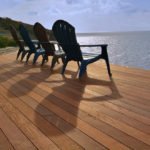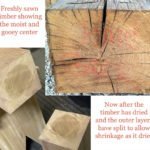
There is no question that the primary use for Ipe is as a decking material. As a decking product, Ipe is surfaced on 4 sides (S4S) and eased on 4 edges (E4E) which prevents splintering and sharp edges in this very, very hard wood. Depending on how our clients choose to install the Ipe decking, we may have to rout a groove for clip fasteners, but at most, that is all we are doing to the wood before shipment.
As a decking material, Ipe is air dried to around 18% moisture content, before it is milled in South America into deck boards. As an exterior product, this is exactly what you want for a stable decking board. Sun, rain, wild temperature swings, etc. are very hard on a board, and using a gently dried, higher moisture content piece is the only way to weather these conditions.
While we do carry rough sawn and kiln dried Ipe lumber, we don’t get much demand for it. This is a wholly different product that is meant for interior use. It is kiln dried to 6-8% moisture content, and we either sell it as rough sawn, or we will mill is onsite at our own millworks. These are the same species yet involve dramatically different treatment and uses. One will not work in the other’s environment.
With that said, did you know that we also carry kiln dried Ipe decking? That’s a bit of a joke because kiln dried Ipe and air dried Ipe are the same product. So this makes your decision easy as “either” product is the best solution for a deck in a dry climate.
Y’see in an earlier time when the world moved at a slower pace, all woods were air dried. Today, production waits for no man and the seasoning process for lumber has to be faster. So even exterior use decking products get put into a kiln for drying. The key here is that the Ipe is NOT dried to the typical 6-8% moisture content of interior use lumber, but rather is kiln dried to 10-18%. This is just enough to get rid of the free water without banishing the bound water and hardening the cell walls of the wood and therefore making it more brittle and resistant to change.
A board that is resistant to change might sound like a good idea, but it is a recipe for catastrophe. You cannot fight moisture change in an exterior environment. Especially a deck which is probably the harshest environment around for wood. The best thing is a board that is flexible and will go with the flow when it rains and the moisture skyrockets or when the sun beats down all day baking the wood dry.

The question you should be asking is not whether to buy kiln dried or air dried (same thing) but how do I install this decking to deal with the specific environmental challenges present on my deck.
A major thing to consider is how much sunlight your deck will get. Direct sun throughout the day can significantly heat up a deck, forcing out moisture very quickly and causing warping. You stack the cards in your favor by laying down a drier board in the first place, paying close attention to ventilation, and gap spacing. But how do you lay down a drier board if these two supposedly different products are the same moisture content? Answer, give it some time on your job site. Let the boards acclimate. If your deck is going down in the desert in the middle of the summer, the weather will naturally drop the moisture content of the decking to the equilibrium point. Once at equilibrium with the surrounding environment the decking will pick up and dump moisture with the change in seasons and rain and sun. This is where selecting gap spacing and paying attention to even air flow will help you much more than a lower moisture content.
This is why the term “air dried decking” is the most common, because it is widely known that the higher moisture content is closest to the equilibrium point for most of the country. But for those of you in the dry climates or with unshaded southern exposure decks, you will hear that installing “kiln dried decking” is the better solution. I cannot say this enough,
THEY ARE THE SAME THING
I think only we the lumber industry are to blame for this misconception. Like I said above kiln dried lumber is usually 6-8% moisture content and as I said, we do actually carry rough sawn Ipe at that level. As a way to differentiate between this 6-8% Ipe and the wetter decking product we naturally started calling the decking air dried. So let me apologize on behalf of the entire lumber industry for confusing the issue with our crazy terms. This won’t be the last time a lumber term confuses and frustrates you. That I can promise you.
J. Gibson McIlvain carries a very large quantity of Ipe in all sizes from decking boards to joists, balusters, and posts. We also carry both air dried and kiln dried Ipe decking. Had enough of that joke yet?
The next time you encounter a project where the decking material is going to be stressed by an “extreme” environment, ask for kiln dried decking…then ask your dealer what the moisture content is on the boards you will be getting. I guarantee that as long as you are buying decking, both the “kiln dried” and “air dried” will be in the same range.









We live in Durango, CO & have a south facing deck. This means we get 300 + days of sunshine, feet of snow in the winter – do you believe your kiln dried wood is a good application?
Just curious.
This is one of those extreme examples I was talking about Bruce. Yes kiln dried is probably a good solution for you. However, I think air dried would work great too if installed in the fall or winter. The bright sun of the Colorado winter isn’t as intense and the lumber would have the whole winter to slowly acclimate. That may be the best solution as air dried material is more flexible at the cellular level and less prone to checking. No matter what your deck will see some heavy wear and tear in those conditions.
My husband used IPE decking to make 2 very simple vanity bases. We just cleaned up the decking boards and applied Tung Oil as a finish, They are at least 8 years old and have held up beautifully in our NC rental home. I love the look, so now I want to use IPE decking boards to make drawer fronts for another vanity (home is in MD). I was looking for 1 x 8 decking boards to use for that purposes, and it was suggested by one distributor that I need kiln dried IPE for that application, not air dried as the decking would be. Is that correct? To be honest, I don’t know how the decking we used for the other vanities was dried.
Yes I would suggest using KD Ipe as well. Most decking is actually dried in a kiln too but it is the amount of drying that is done that is the issue. Decking being an exterior product is not dried all the way down to 6-8% moisture content and usually is left with higher moisture so that it performs better out in the elements. For wood in interior use you will want it dried all the way down to the 6-8% range because this makes a more stable boards with slightly hardened cell walls that inhibit some of the movement. To be honest using decking boards could work but it also could result in cracks or cupped boards that as a drawer front won’t close properly or bind inside the case depending on the type of drawer front made.
Thank you for your great information! We live on Oakland and are installing an Ipe deck in the summer. It looks like the equilibrium moisture content of wood in this area at this time is about 13-14%. Does that mean kiln dried is the way to go, or does it matter? Also, how long would either AD or KD Ipe decking take to acclimate?
I think an AD product is best with that kind of MC but honestly KD will work just fine too because you are installing in the summer months and the boards will be swollen with moisture. Still Oakland is pretty dry and the moisture swings won’t be that significant. I wouldn’t hesitate to install either AD or KD and you might check with your dealer on what they have and what the actual MC is of those boards. In the end, let the boards acclimate a week or two on the site before you install and that will allow them to acclimate.
Thank you, Shannon! Another source of confusion I read about is how much of a gap to leave between the boards? In my case boards are 5/4 x 6 (1 x 5.5) inches.. The deck will be installed in the summer and the decking will be kiln dried.
I’ve read anywhere from 1/16th to 3/16th spacing. From what I could tell based on reading your articles, if the wood is acclimated and I am installing in the summer months, then I should leave a gap of maybe 1/16th because it will most likely shrink during the rainy winter months? Any thoughts?
Thank you again for sharing all of your knowledge with people like me.
You are correct. The boards are swollen in the heat and humidity now and will only shrink from here. 1/16th is not a bad place to start but 3/32 is a bit more accepted in the industry to the point where if you were using hidden fasteners you will have 3/32 as an option for your spacing.